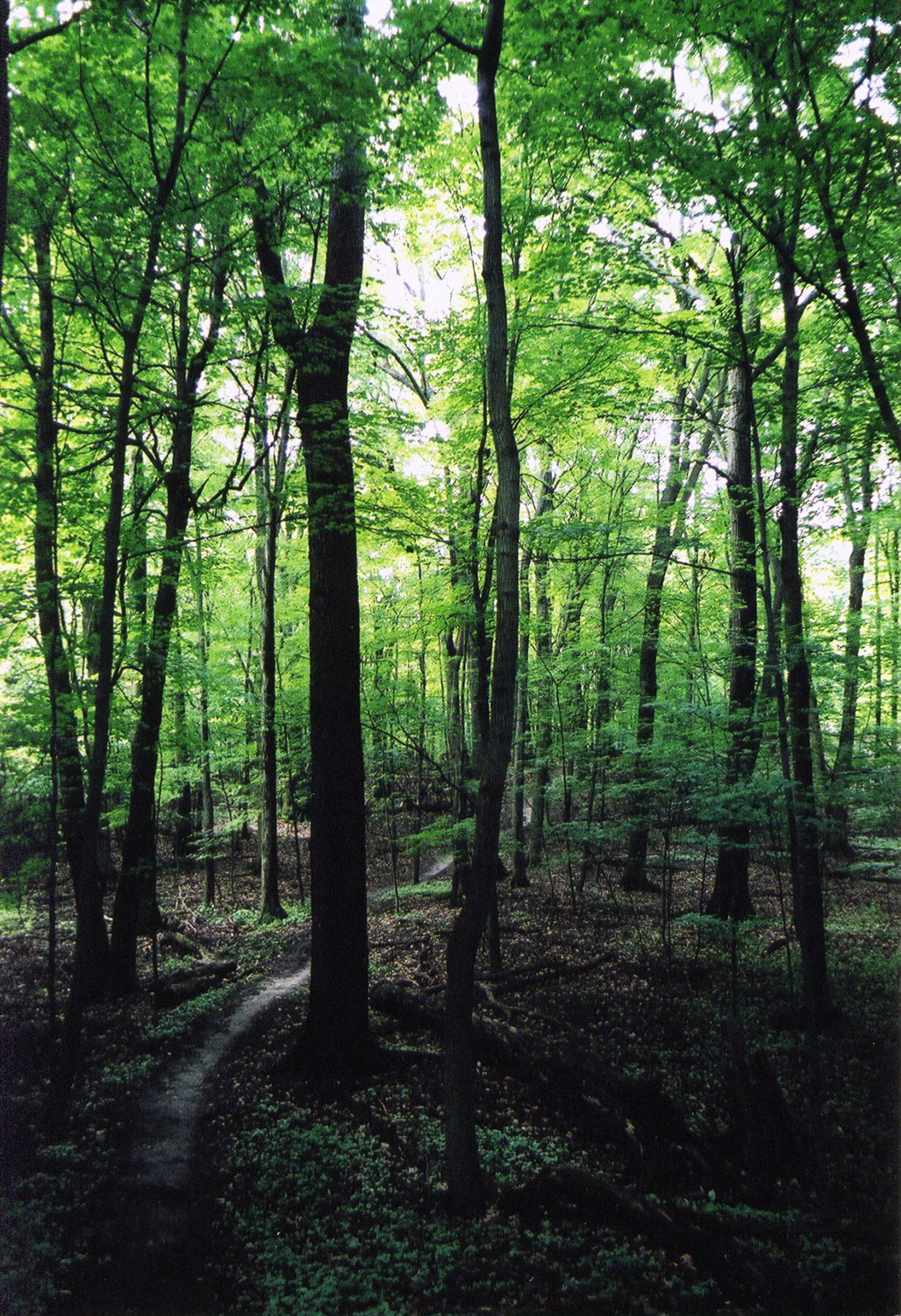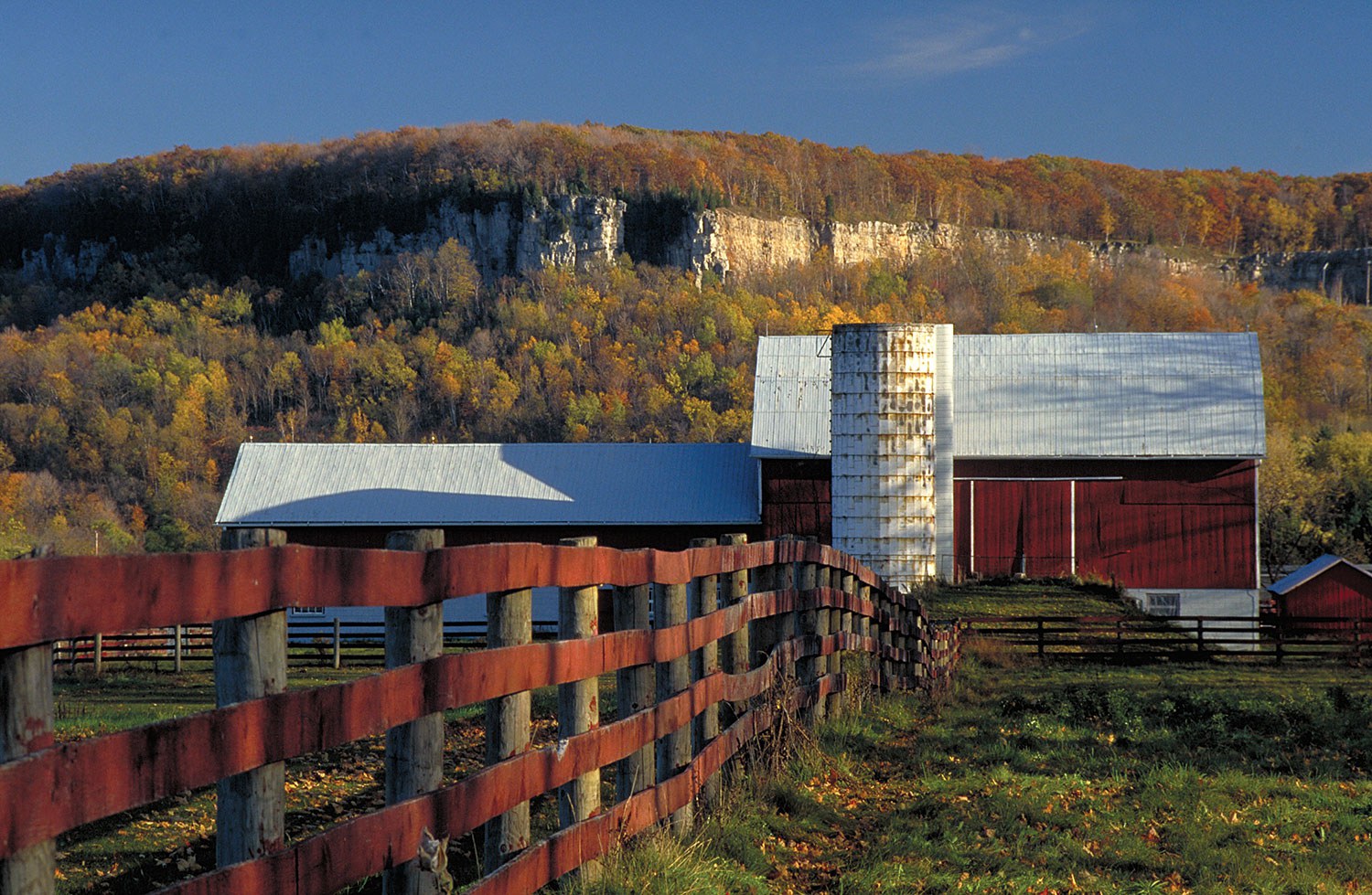

Browse by category
- Adaptive reuse
- Archaeology
- Arts and creativity
- Black heritage
- Buildings and architecture
- Communication
- Community
- Cultural landscapes
- Cultural objects
- Design
- Economics of heritage
- Environment
- Expanding the narrative
- Food
- Francophone heritage
- Indigenous heritage
- Intangible heritage
- Medical heritage
- Military heritage
- MyOntario
- Natural heritage
- Sport heritage
- Tools for conservation
- Women's heritage
Reading the landscape
Cultural landscapes
Published Date: Sep 09, 2016
Photo: While the original Prince Edward County survey showed a complete network of roads, frequently the road allowance remained unopen. Although incomplete, it still adds visual interest to the rural landscape. (Photo: Wendy Shearer)
An important value of learning to observe and understand the cultural landscape is to see how natural features and processes have been modified or enhanced in the past as a way of creating a sustainable way of life. J.B. Jackson, noted educator and writer about vernacular landscapes, once stated that “Landscape is history made visible.” This insight into the cultural landscape recognizes that there is much to be seen and much to be understood about our past.
As we travel around the province, there are many indications – both obvious and subtle – of past natural and human activities. This evidence is visible in vegetation patterns, circulation networks, and the buildings and structures comprising our cultural landscape. Even where past uses have stopped, some of the details and patterns may persist, revealing a long history of use. For example, in the rural landscape, surviving tree lines of Norway spruce within open fields indicate the location of the historical farm core with its numerous outbuildings, barn, laneway and farmhouse – still visible long after the structures have been removed.
There is value in being able not only to observe our surroundings but also to understand the natural, economic and cultural influences that have shaped our society. The evidence in the landscape reveals past human activities aimed at survival, stewardship and sustainability. There are lessons to be learned from understanding how resources have been used to advantage over the centuries, and how different periods have assigned different values to the landscape.
Some natural forces, such as the retreat of the ice field that covered most of Ontario, have left an indelible mark on the current landscape. The existing landform, topography, underlying geology and drainage patterns created during the ice age have set a stage on which human activities have occurred, creating the cultural landscape we value today. The limestone Niagara Escarpment, the granite Canadian Shield and the fertile glacial till plains of southwestern Ontario have each influenced the range and success of settlement patterns still visible today. For example, the distinctive stone farmhouses in Waterloo and Wellington counties are constructed with limestone quarried locally or from granite fieldstone that emerged from the melt waters. In contrast, the counties in southwestern Ontario have few stone domestic buildings, using instead the timber resources found in abundance in that region.
There is increasing awareness of cultural heritage landscapes through policies and procedures aimed at their protection and conservation. Several types are recognized, designed, continuing (relic and evolved) and associative. (Refer to the Ontario Heritage Trust’s information sheet on Cultural Heritage Landscapes – An Introduction, revised November 2012, for examples and references.) There are examples of each of these types interwoven in our existing landscape.
Historical research and archival photos provided valuable details about the design of the Italianate gardens at Fulford Place and guided its restoration.
Fulford Place in Brockville is an excellent example of a designed cultural landscape where the reading of the existing landscape confirmed many of the important details of the original Italianate garden needed for its conservation. At the beginning of the 21st century, the Trust initiated the restoration of this early-20th-century garden on the side yard of George Fulford’s expansive residence. Fulford Place reflects the style of the golden country estate era, when grand homes frequently overlooked a formal Italianate garden. The natural slope of the property towards the St. Lawrence River was dramatically altered with the addition of more than 5 metres (16 feet) of soil to create the necessary flat terrace.
Benefitting from an extensive archival record of correspondence, photos, newspaper articles and the original 1902 Olmsted plans, the return of the Italianate garden began. The exact location of the geometric beds was visible in the later photos of the garden and onsite long after they had been covered with a blanket of sod. Using the combination of historical research and remaining visible evidence on the site, the gardens were faithfully restored.
It is possible to read the past in the features of an evolved and evolving cultural landscape. In southwestern Ontario along the north shore of Lake Erie, there are continuing patterns of kilometres of cedar hedges cross-stitching the fields. This landscape feature is rooted in the past history of the region where, by 1900, only 20 per cent of the forest cover remained. At the same time, the nutrient levels in the sandy soils were low; dry climatic conditions created soil loss by wind erosion. The active planting of evergreen windbreaks was undertaken in the 1920s to retain the soil. Today, these lines of cedars continue to be a distinctive feature of the agricultural landscape. While the field crops have continued to evolve and diversify from tobacco and potatoes to ginseng and asparagus, the evidence of this early forestry practice is visible and informs the community of the valuable lessons learned about soil management.
One of the most obvious remnants of past activity that can still be read in the landscape is the layout and alignment of the road grid established throughout the province in the early 19th century by British military surveyors. This orderly pattern has been the foundation for the creation of our rural agricultural landscape and for the predictable locations of crossroad settlements.
In some cases, the grid network coincided with earlier pre-contact routes that were direct links between resources. For example, one of the earliest trails that connected the Niagara Peninsula to the north shore of Lake Ontario ran through what is now known as Burlington Heights – a partial land bridge used for centuries by First Nations peoples, and in the 19th century, by settlers such as Sir Allan MacNab for Dundurn National Historic Site, and in the 20th century by Thomas McQuesten for the location of the Royal Botanical Gardens at Hamilton’s gateway. The topography of the area provides remarkable views to the water of Cootes Paradise on the inland side and sheltered Burlington Bay on the lake side, and is evidence of the landform created by the glacial retreat. The Niagara Escarpment creates a sheltered natural environment where rare and unique plant and animal communities flourish. The visitor travelling along this route today is able to see thousands of years of natural processes providing a benevolent setting for later centuries of improvement works.
The rural road grid pattern is frequently reinforced by tree lines of sugar maples. These tree lines are a distinctive reminder of the historical practice where farmers would plant trees along their farm frontages. Observing these tree lines evokes an appreciation for the past actions of individuals that resulted in a benefit for the broader community.
By the middle of the 19th century, an extensive rail network formed part of the economic framework of the province. Small communities on the rail lines experienced prosperity and growth. In the 20th century, changes in transportation resulted in the removal of many lines, leaving evidence of their past layout still visible in the landscape.
While it is easier to see patterns in the alignment of roads, buildings and vegetation, it is also important to appreciate the meanings found in the remnant details in the landscape. For example, just as the type of building material used in vernacular structures will reflect available local materials and craftsmanship, other landscape details will reveal much about the history of local development. In eastern Ontario, for example, the standard design for the common cedar rail fence involved a zigzag or tripod style where the fence sat directly on the ground. In other parts of Ontario, cedar fences relied on posts installed in the ground with rails added between each section. This change in pattern reveals changes in the bedrock geology and the depth of the topsoil. The observable evidence of the different fence types reveals the resourcefulness and efficiency of the builder.
Reading the landscape is a valuable way to appreciate the activities that have left a mark on the environment. Observation alone, however, cannot tell the entire story of the history of a place. Historical resources – photos, Tweedsmuir histories, insurance maps, census records, land registry records and published local histories – can fill in the missing pieces of information about how the cultural landscape was created. Once this important background information is collected, a return visit to observe the landscape remnants and features again is in order, resulting in a greater appreciation of the variety of components that comprise the cultural landscape.



























